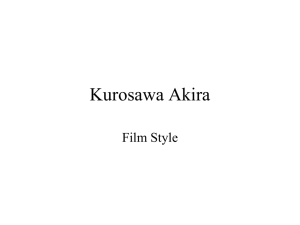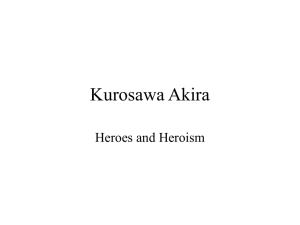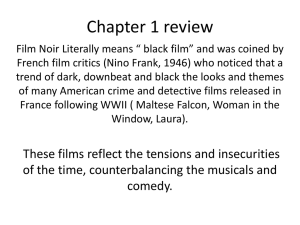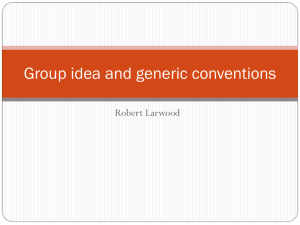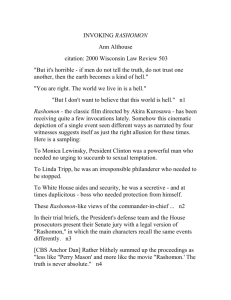Kurosawa Akira
advertisement
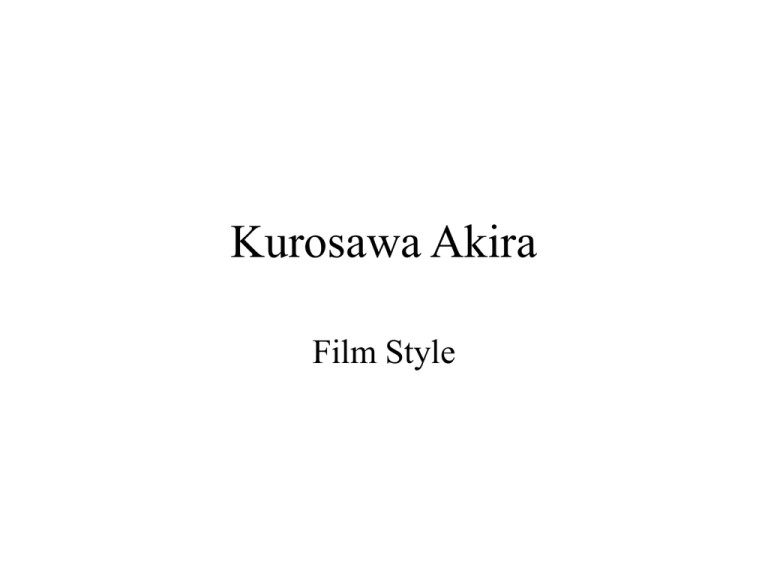
Kurosawa Akira Film Style Perfectionist “Movie directors, or should I say people who create things, are verygreedy and they can never be satisfied. That‘s why they can keep on working. I‘ve been able to work for so long because I think next time I‘ll make something good." Perfectionist Total control over his film auteur ‘I am my film … nothing more and nothing less.’ Kurosawa Akira • Screenwriter, director and editor • He expected the same enthusiasm and dedication from his staff and coworkers. Perfectionist Anecdotes • Nickname Emperor • The director who made something impossible possible. • 20 tons of water was used for the opening scene of Rashomon and the local area ran out of water. • The water was coloured with calligraphy ink. • He demanded all furniture had to be antique and they had to be filled with antique clothes and materials. • Kurosawa got the roof of a Perfectionist house removed to film a short scene from a train in Tengoku to Jigoku. • Kurosawa demanded to change the direction of river flow for better visual effects. • Kurosawa asked actors call each other by the names of the character that they played and wore their costumes before, during and after rehearsals. Perfectionist • Kurosawa used real arrows for the concluding scenes of Throne of Blood. Master archers aimed at the targets only inches away from Washizu’s body. Hyper-stylistic Filmmaking • Film style to appeal to the emotion rather than intellect of the spectator • Psychological rather than mimetic realism (Mimesis = mimicry and copying of reality) Hyper-stylistic Filmmaking • The emotional appeal is multiplied by visual images and sound effects being brought together. • Heightened psychological realism - expressive mise-en-scène (acting, lighting, camera work, and composition). Hyper-stylistic Filmmaking • Visual dynamism and kineticism - epic scale movement of the subjects on the screen shot by multiple camera and edited in frantic paces. • The final battle sequence of Seven Samurai shot with 8 cameras and edited rapidly. Hyper-stylistic Filmmaking Cinematic sound is that which does not simply add to, but multiplies, two or three times, the effect of the image. Kurosawa Akira Hyper-stylistic Filmmaking • Sound effects of beating rain, running horses, their cries, splashing water, men’s yelling mixed together to create dynamic sound track in Shichi Nin no Samurai. Hyper-stylistic Filmmaking • Emotional appeal and psychological realism achieved by lighting and camera work. • Rashomon - shot by Miyagawa Kazuo, the photographer of Mizoguchi Kenji Hyper-stylistic Filmmaking • Geometrical and painterly compositions enhance psychological effects on the audience - two police detectives pursuing the murderer who has killed people using the gun that he stole from them vertical shadows of grills create create psychological suspense (photo, Stray Dog) Hyper-stylistic Filmmaking • The bed of flowers on which the young couple lie or sit - creating lyrical effects in No Regrets for Our Youth and Seven Samurai Hyper-stylistic Filmmaking • Paisley patters of the futon hang to dry in Red Beard was shot with a telephoto lens. Depth disappeared and two dimensional quality emphasized the patterns. Hyper-stylistic Filmmaking • Natural phenomenon visually and aurally emphasizes the emotional atmosphere of the scene. • Howling wind and fierce rain • Strong wind churning up sand - bleak townscape Yojinbo Hyper-stylistic Filmmaking • The opening scene of Rashomon, a ruined gate in a great storm. • Natural phenomenon reveals the smallness and weakness of the human being and its rational power and moral strength. Hyper-stylistic Filmmaking • Snow in the park which Watanabe greatly contributed to get built and where he dies. Ikiru • Loneliness and ephemerality Hyper-stylistic Filmmaking • Intense heat in Stray Dog and High and Low • Heat is metaphor for corruption, social impoverishment, and criminality Hyper-stylistic Filmmaking • Dense fog and mist - hinting the existence of super-natural being and super-human power. • Throne of Blood, Ran and Dreams

